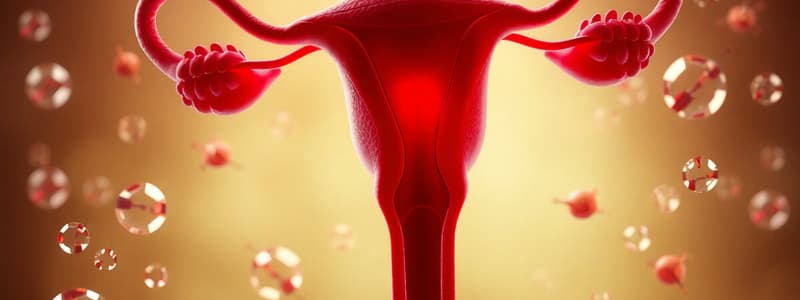Podcast
Questions and Answers
Which of the following correctly describes the sequence of events in fertilization?
Which of the following correctly describes the sequence of events in fertilization?
- Recognition, fusion, binding, activation
- Fusion, binding, recognition, activation
- Recognition, binding, fusion, activation (correct)
- Binding, recognition, activation, fusion
The urethra in the male reproductive system serves as a shared pathway for both sperm and urine.
The urethra in the male reproductive system serves as a shared pathway for both sperm and urine.
True (A)
What is the primary role of the follicle-stimulating hormone (FSH) in males?
What is the primary role of the follicle-stimulating hormone (FSH) in males?
Stimulating sperm production
The ______ is a sac outside the body cavity where sperm development occurs at a lower temperature.
The ______ is a sac outside the body cavity where sperm development occurs at a lower temperature.
Match the hormone with its primary function in the male reproductive system:
Match the hormone with its primary function in the male reproductive system:
Which of the following best describes the function of the seminal fluid?
Which of the following best describes the function of the seminal fluid?
Each ovary contains around 400 follicles, each of which will release an egg during a woman's lifetime.
Each ovary contains around 400 follicles, each of which will release an egg during a woman's lifetime.
What is the role of the corpus luteum during the luteal phase of the menstrual cycle?
What is the role of the corpus luteum during the luteal phase of the menstrual cycle?
The ______ is the opening at the bottom of the uterus that dilates during labor to allow the baby to pass through.
The ______ is the opening at the bottom of the uterus that dilates during labor to allow the baby to pass through.
What is the primary function of the fallopian tubes in the female reproductive system?
What is the primary function of the fallopian tubes in the female reproductive system?
Flashcards
Fertilization
Fertilization
The fusion of male and female reproductive cells during sexual reproduction.
Hormone (in puberty)
Hormone (in puberty)
A molecule released by ovaries/testes triggering sexual development.
Puberty
Puberty
Period of rapid growth and sexual maturation (ages 9-15).
Male reproductive system
Male reproductive system
Signup and view all the flashcards
Female reproductive system
Female reproductive system
Signup and view all the flashcards
Scrotum
Scrotum
Signup and view all the flashcards
Vas Deferens
Vas Deferens
Signup and view all the flashcards
Prostate
Prostate
Signup and view all the flashcards
Menstrual Cycle
Menstrual Cycle
Signup and view all the flashcards
Fallopian Tubes
Fallopian Tubes
Signup and view all the flashcards
Study Notes
- Fertilization is the process where male and female reproductive cells join during sexual reproduction.
- General steps of fertilization involve sperm and egg cell contact/recognition, binding, fusion, and activation into a zygote.
Sexual Reproduction and Hormones
- Hormones, released by ovaries and testes, instigate sexual development during puberty.
- Puberty ranges from ages 9-15.
- Female/male reproductive systems are fully developed by the end of puberty.
Male Reproductive System
- The primary function is to produce and deliver sperm.
- Testes are located in the scrotum, which maintains a lower temperature for effective sperm flagella growth.
- Sperm needs to be slightly colder than body temperature to make flagella grow effectively
- The vas deferens is a tube-like structure that empties into the urethra.
- The shared Urethra exits for both sperm and urine (unlike females).
- The prostate produces seminal fluid containing carbohydrate-rich nutrients for sperm.
- Semen comprises seminal fluid and sperm.
- Sperm's goal is to fertilize the right egg.
- Between 20-150 million mature sperm cells are present in 1 milliliter of semen.
Male Reproductive System: Hormones
- As males approach puberty, the brain signals the body to produce luteinizing hormone (LH) and follicle-stimulating hormone (FSH).
- LH stimulates the testes to produce testosterone.
- Testosterone stimulates the development of male secondary sex characteristics and, with FSH, stimulates sperm development.
- FSH stimulates the testes to produce sperm.
- Both FSH and LH are produced in the pituitary gland.
Female Reproductive System
- Ovaries contain follicles with a developing egg cell.
- Each ovary contains around 400,000 follicles, but only about 400 eggs will be released in a lifetime.
- Fallopian tubes provide a passageway for egg and sperm cells to meet and travel to the uterus after fertilization.
- The uterus is a hollow muscular organ where the blastocyst attaches and grows during pregnancy.
- The cervix is an opening at the bottom of the uterus that opens during labor for childbirth.
- The vagina/vaginal canal leads to the outside of the body.
Menstrual Cycle
- It is a series of events preparing the body to care for a fertilized egg, it has 4 phases
- During the follicular phase, the brain secretes FSH and LH, stimulating the follicle to develop and secrete estrogen.
- LH triggers the ovary to release the egg.
- Estrogen controls meiosis in females, signaling when the female egg is mature and ready to leave the ovary.
Ovulation
- Egg is released into the ovary.
- Egg travels into fallopian tubes where it will be fertilized (if there’s sperm cells present)
- Egg (fertilized/unfertilized) pushed toward uterus
- Ovulation occurs around day 14 of the menstrual cycle egg cell is available for fertilization.
Luteal Phase
- As the egg moves through the fallopian tubes, the ovarian follicle turns yellow and becomes the corpus luteum.
- The corpus luteum secretes progesterone, which stimulates blood vessel growth in the uterine lining to prepare for embryo implantation.
Studying That Suits You
Use AI to generate personalized quizzes and flashcards to suit your learning preferences.




